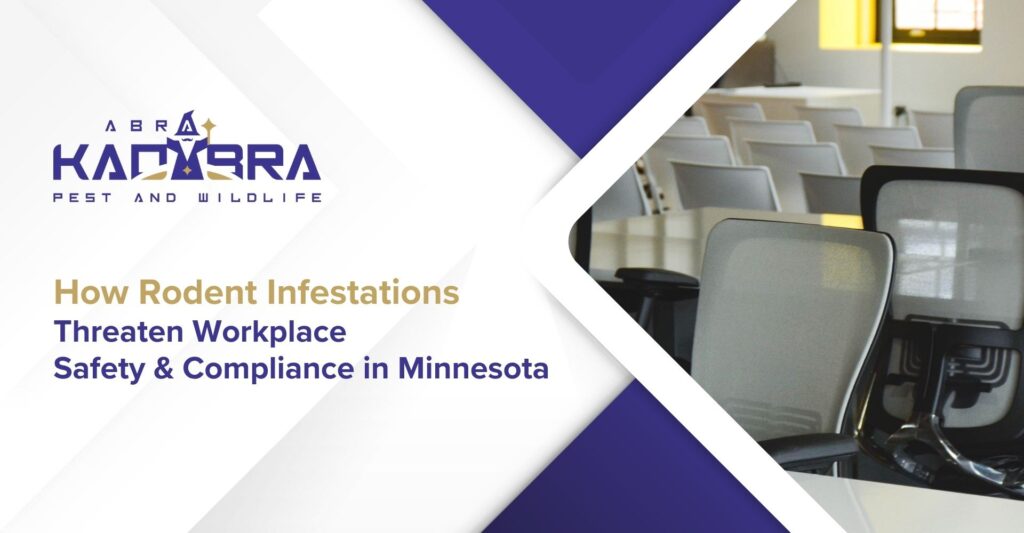When most people think about rodents, they picture a nuisance at home: a mouse in the kitchen or a rat in the garage. But for Minnesota businesses, rodent infestations inside the workplace are more than just a headache. They present serious risks to employee safety, public health, and regulatory compliance.
Whether you operate a food processing facility in St. Cloud, a warehouse in the Twin Cities, or an office space in the suburbs, rodents can threaten your business operations, your reputation, and even your ability to stay compliant with health and safety standards.
In this article, we’ll break down the dangers rodents pose in Minnesota workplaces, explore compliance requirements, and share how Abra Kadabra Environmental Services helps businesses stay safe and pest-free.
Why Rodents Are a Big Problem in Minnesota Workplaces
Seasonal Pressures in the Upper Midwest
Minnesota’s long, harsh winters drive mice and rats indoors in search of warmth and food. Commercial buildings become ideal shelters because they offer steady temperatures, hidden spaces for nesting, and access to food sources.
Rodents in Minnesota don’t just disappear with the snowmelt. During spring and summer, their populations increase rapidly, and businesses see renewed pressure from rodent activity in loading docks, dumpsters, and warehouses.
That means year-round vigilance is required to keep them out of workplaces.
The Hidden Risks of Rodents in Workplaces
1. Health and Sanitation Threats
- Disease transmission: Rodents carry over 35 diseases, including salmonella, leptospirosis, and hantavirus. These can spread to employees through droppings, urine, and contaminated surfaces.
- Food contamination: Minnesota’s strong food production and hospitality industries are particularly vulnerable. Just a few droppings in a food storage area can trigger a Department of Health violation or customer complaints.
- Allergens: Rodent dander and droppings are known triggers for asthma and allergic reactions among employees.
2. Safety Hazards
- Fire risk: Mice and rats are notorious for chewing on wires. In an industrial setting, chewed electrical lines can spark fires or cause costly power outages.
- Slip-and-fall risks: Droppings or nesting debris left in walkways and storage areas create unexpected hazards.
- Equipment damage: Rodents nesting in machinery or HVAC systems can lead to breakdowns and unsafe working conditions.


3. Business and Compliance Risks
- OSHA compliance: Under federal OSHA standards (29 CFR 1910.141), employers must maintain workplaces free from vermin. Minnesota OSHA (MNOSHA) enforces these standards locally.
- Minnesota Department of Health regulations Require Businesses that handle food or beverages to maintain sanitary, pest-free environments. Violations can result in fines or forced closures.
- Reputation damage: A single rodent sighting can lead to negative reviews, social media backlash, or lost contracts — especially in industries like hospitality, healthcare, and food processing.
Industries at Highest Risk in Minnesota
While any workplace can be vulnerable, specific Minnesota industries face greater risks:
- Food and beverage facilities (breweries, food processors, restaurants, grocery stores) – contamination is a constant concern.
- Warehouses and logistics hubs – with goods constantly moving in and out, there are endless opportunities for rodents to enter.
- Healthcare facilities – strict sanitary standards mean even minor infestations can trigger compliance issues.
- Schools and universities – with large kitchens and plenty of storage areas, rodents can thrive if prevention isn’t prioritized.
- Manufacturing plants – rodents chewing wires or nesting in equipment can cause costly downtime.
The Cost of Non-Compliance
For Minnesota businesses, failing to address rodent issues goes beyond just pest control bills. The hidden costs include:
- Regulatory fines – Non-compliance with health or OSHA standards can result in penalties or work stoppages.
- Liability claims – If an employee or customer becomes sick or injured due to rodent contamination, businesses may face lawsuits.
- Lost contracts – Commercial clients may cut ties with suppliers or vendors that can’t maintain pest-free facilities.
- Damage to brand reputation – In a state like Minnesota, where word travels fast in tight-knit communities, a single infestation can seriously damage trust.
How to Prevent Rodent Infestations in Minnesota Workplaces
The best defense against rodents is a proactive plan. At Abra Kadabra Environmental Services, we use an Integrated Pest Management (IPM) approach — a combination of prevention, monitoring, and treatment.
Here are essential steps every Minnesota business should take:
1. Conduct a Facility Inspection
Look for signs of rodent activity:
- Droppings along walls or near food storage
- Gnaw marks on packaging, wires, or wood
- Nesting material in quiet corners, ceilings, or equipment
- Burrows near building foundations


2. Seal Entry Points
Minnesota’s cold winters drive rodents through even the smallest gaps. Seal:
- Cracks in foundations
- Gaps around doors, docks, and windows
Openings around pipes and utility lines
3. Improve Sanitation
- Store food and waste in rodent-proof containers.
- Empty dumpsters regularly and keep them away from building entrances.
- Train employees on proper food storage and cleanup.
4. Implement Monitoring & Trapping
Regular inspections with bait stations and traps help detect activity early. In Minnesota, seasonal monitoring is critical, especially before winter.
5. Work with a Licensed Pest Control Partner
DIY solutions rarely keep up with Minnesota’s rodent pressures. Partnering with a licensed, experienced team like Abra Kadabra ensures you’re not only rodent-free but also compliant with state and federal regulations.
Schedule a consultation with our team
Why Minnesota Businesses Choose Abra Kadabra
As a family-owned pest and wildlife control company based in the Twin Cities, Abra Kadabra understands the unique challenges Minnesota businesses face. From winters that drive rodents indoors to strict health regulations for food businesses, our team is experienced in tailoring solutions that work.
Here’s what sets us apart:
- Certified Technicians – Our team is trained and certified in Integrated Pest Management (IPM) best practices.
- Commercial Expertise – We work with restaurants, schools, warehouses, healthcare facilities, and more across Minnesota.
- Eco-friendly Approach – We use environmentally responsible treatments whenever possible to protect your employees and customers.
- Long-term Prevention – Our goal isn’t just to remove rodents, but to keep them out for good.
Discover our full range of pest & wildlife services
Quick Tips for Minnesota Facility Managers
- Fall Prep: Seal entry points before the first frost; rodents look for shelter early.
- Winter Checks: Inspect storage and mechanical rooms regularly during cold months.
- Spring Cleanup: Remove clutter, debris, and vegetation that attract rodents.
- Summer Monitoring: Watch for increased activity around dumpsters and loading docks.
Final Thoughts
Rodent infestations in Minnesota workplaces aren’t just damaging to reputation; they’re a direct threat to safety, compliance, and business continuity. From spreading disease to damaging equipment and violating health codes, rodents can disrupt operations and hurt your bottom line.
The good news is that with the right prevention plan and a trusted partner, you can protect your workplace, your employees, and your reputation.
At Abra Kadabra Environmental Services, we’ve helped countless Minnesota businesses stay rodent-free. Whether you need a one-time remediation or an ongoing commercial pest control program, we’re here to help.
Contact us today to schedule a rodent inspection and keep your workplace safe and compliant.

